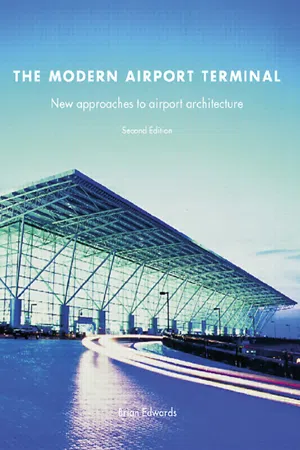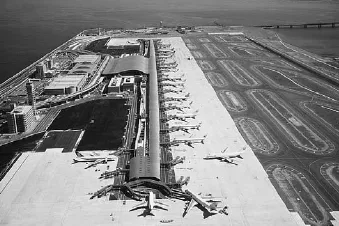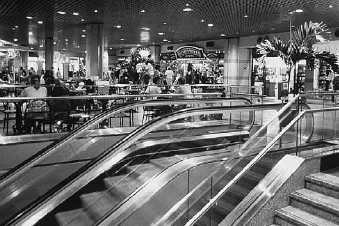
- 304 pages
- English
- ePUB (mobile friendly)
- Available on iOS & Android
eBook - ePub
About this book
This comprehensive guide to the planning and design of airport terminals and their facilities covers all types of airport terminal found around the world and highlights the environmental and technical issues that the designer has to address. Contemporary examples are critically reviewed through a series of case studies. This new edition covers the most recent examples of high quality, technically advanced designs from the Far East, Europe and North America.
This book will be a source of inspiration and guiding principles for those who design, commission or manage airport buildings.
Frequently asked questions
Yes, you can cancel anytime from the Subscription tab in your account settings on the Perlego website. Your subscription will stay active until the end of your current billing period. Learn how to cancel your subscription.
No, books cannot be downloaded as external files, such as PDFs, for use outside of Perlego. However, you can download books within the Perlego app for offline reading on mobile or tablet. Learn more here.
Perlego offers two plans: Essential and Complete
- Essential is ideal for learners and professionals who enjoy exploring a wide range of subjects. Access the Essential Library with 800,000+ trusted titles and best-sellers across business, personal growth, and the humanities. Includes unlimited reading time and Standard Read Aloud voice.
- Complete: Perfect for advanced learners and researchers needing full, unrestricted access. Unlock 1.4M+ books across hundreds of subjects, including academic and specialized titles. The Complete Plan also includes advanced features like Premium Read Aloud and Research Assistant.
We are an online textbook subscription service, where you can get access to an entire online library for less than the price of a single book per month. With over 1 million books across 1000+ topics, we’ve got you covered! Learn more here.
Look out for the read-aloud symbol on your next book to see if you can listen to it. The read-aloud tool reads text aloud for you, highlighting the text as it is being read. You can pause it, speed it up and slow it down. Learn more here.
Yes! You can use the Perlego app on both iOS or Android devices to read anytime, anywhere — even offline. Perfect for commutes or when you’re on the go.
Please note we cannot support devices running on iOS 13 and Android 7 or earlier. Learn more about using the app.
Please note we cannot support devices running on iOS 13 and Android 7 or earlier. Learn more about using the app.
Yes, you can access The Modern Airport Terminal by Brian Edwards in PDF and/or ePUB format, as well as other popular books in Architektur & Architektur Allgemein. We have over one million books available in our catalogue for you to explore.
Information
Part one
Airport design
CHAPTER 1
The airport industry
Aviation is a major international industry, which in 2003 carried over 1.3 billion passengers. Of all forms of transport, flying is the most cost-effective, the fastest and increasingly the safest form of long-distance travel. For most international journeys travel by air is the only option, and to make it comfortable and reliable, international standards and regulations apply. These influence the layout, engineering and infrastructure of airports, the design of terminal buildings, and the specification of the aircraft themselves. Civil aviation is therefore a highly regulated and efficient industry, which recognizes few national boundaries or customs. The standardization of operational practices leads to greater safety on and off the ground, and provides an element of uniformity in the criteria that shape airports themselves. Hence runways, taxiing areas, safety zones, passenger piers and terminal buildings all confirm to relatively standardized operational parameters.
The infrastructure of airports consists of five basic zones: the runway, the aircraft fuelling and maintenance areas, the aircraft stands, the passenger piers and the terminal buildings. These are the primary functional divisions that establish the layout and operation of the airport. Secondary areas or buildings may include the flight control tower, connecting forms of transport (such as railway stations or light rail systems), the road system, car parks and hotels.

1.1 Marseille Airport, France, extended in 1994 by the Richard Rogers Partnership.
To regulate the aircraft industry, governments have tended to delegate control to industrial organizations in the air transport business. There are three prime international bodies:
- the International Air Transport Association (IATA), which represents the interests of aircraft carrier members, such as British Airways and Air Canada.
- the Airports Association Council International (AACI), which represents civil airport authorities such as the BAA (previously British Airports Authority).
- the Institute of Air Transport (ITA), which represents those other than carriers and airport owners, such as managers, manufacturers and designers.
These three bodies effectively self-regulate and provide a policy framework for the aircraft industry. Because many national governments are little bigger (in GNP terms) than the larger carriers, or generate less wealth than a major international airport such as Heathrow, most governments accept the beneficial influence of these powerful industrial organizations. In addition, there are important national regulatory bodies such as the Civil Aviation Authority in the UK and the Federal Aviation Administration in the USA.
Ownership of airports
The trend these days is away from ownership of airports by the state (either central or regional government) towards either private ownership or partnership between government and private investors. London Stansted is owned by BAA (which is wholly private and quoted on the Stock Exchange), and other major airports, such as Stuttgart in Germany and Milan in Italy, have been denationalized and are now no longer state owned. The reasons are clear: airports require massive injections of funds to adapt to changing regulation, market conditions and commercial opportunity. Only with private capital can the outmoded infrastructure of airports be kept up to date – or so most Western governments believe. In the developing world it is still commonplace for the state or local authority to own and manage airports, but as soon as they become profitable they are quickly sold, often to international organizations. Although many governments cling to the idea that their major airports are part of the state infrastructure of public utilities, in reality the past 10 years have seen a shift worldwide away from government ownership towards some sort of consortium ownership or total private ownership. The prime question, however, is not about who owns the airport, but rather: does the air transport industry exist to provide a public service, or profit for the shareholders? The pattern of ownership throughout the world tends to follow the varying ideologies of the respective governments rather than any obvious regional or subcontinental pattern.
1.2 Kansai Airport, Osaka, Japan: a major public investment in transport infrastructure with private stakeholders. Architects: Renzo Piano Building Workshop.

If ownership of airports by governments is declining, there remains a strong group of airports (such as Kansai in Japan) run by a consortium of state and local government, with private companies having a financial stake. Sometimes the airport may be owned by an arm of government, but the principal buildings (such as the passenger termini) are owned, leased or managed by a private organization such as an airline company. The mix of ownership has implications for the operation of the airport and – to some extent – for the design of the parts. Where ownership is vested in government there tends to be a controlling hand over the appearance of the whole airport estate, from hotels to car parks, terminal buildings to control towers. Where ownership is fragmented, or resides in a consortium, there is usually greater pluralism in the approach to design, and often the employment of a wider selection of architects, designers and engineers. Where there is a split in ownership between the airport and its key buildings (as at Kennedy Airport, New York) the pattern is usually one where different airlines own specific passenger terminals. This allows them to compete with each other as integrated terminal-based services – including ticketing, baggage handling and concessionary shops – all managed by the airline company with which the passenger is flying.
1.3 Retail sales now exceed landing fees at most airports. Southampton Airport, UK. Architects: Manser Associates.

How airports generate income
For the passenger, the airport is a point of arrival or departure – just another stage in the complexity of modern travel – but for the operator the airport is a means of generating income. Generally speaking, there are five ways of earning revenue:1
- landing fees
- concessions in terminal buildings
- leasing arrangements with airline operators
- leasing of non-airline operations such as car parks
- equipment rental (such as baggage handling).
Against these earnings. the airport owner has to set two operating expenses:
- maintenance costs (upkeep of buildings, facilities and equipment)
- operating costs (staff salaries, security, utilities costs).
The balance of revenue and expenses determines the profitability or otherwise of the airport. Contrary to expectations it is not the airlines that necessarily generate the bulk of the airport earnings. At Stansted the revenue from the car parks exceeds the landing fees paid by the airline companies, and at Heathrow the money earned through the sale or lease of concessions is one of the principal sources of income, again exceeding the landing fees.2
In these balances of profitability, the terminal buildings play a very large part. As an airport expands, generating more traffic flow, the percentage of income from the terminal building itself increases. The increase in throughput of passengers adds greatly to the sale of concessionary and duty-free goods, adding to the fees earned through leasing terminal space to retail and restaurant companies. Growing operational activity is therefore the main aim of the airport operator, who may reduce the fees charged to airline companies (for landing and aircraft parking, etc.) in order to increase the throughput of passengers.
Generally, the larger the airport the greater the percentage of income from the passenger terminal. With small airports (serving up to about 200 000 passengers a year) the landing fees, fuel charges, hangar rentals etc. exceed the revenue from terminal areas by about 25 per cent, but with large airports (serving over 4 million passengers a year) income from the terminal exceeds that of the landing area by 40 per cent.3 For the typical airport, landing fees account for about 20 per cent of total income, but revenue generated by commercial activities of one kind or another (such as concessions in the terminal building and rents to franchising companies) can approach 50 per cent of total income.
Looking more closely at the sources of income generated in the terminal area, evidence from the USA shows that car rentals, parking fees, restaurant leasing fees and fees from speciality shops generate about 80 per cent of the revenue. The implications are obvious in terms of the design and management of such areas: create as much space in or around the terminal for these secondary activities, ensure that the environments formed are conducive to loitering en route to the plane, and (if possible) manage flight departures to maximize ‘dwell time’.
Because much of the commercial revenue is the result of duty-free shopping (27 per cent of BAA’s total earnings in 1995), a recent trend has been towards providing such shops not only at the beginning of a flight (and during it) but on arrival. Although this allows the airport to exploit both departing and arriving passengers, the move has been resisted by airlines themselves, who derive considerable sales (especially with holiday charter flights) from on-board purchases. However, there is the advantage of reduced congestion and less weight on planes in transferring duty-free to the end rather than the beginning of a journey. For the operator and designer of the terminal building there are implications in re-ordering duty-free shopping. The arrivals area is one of the most congested and controlled of all zones in the terminal building, and customs staff have resisted the change. However, where arrivals duty-free shopping does occur (as at Bangkok and Singapore), the additional income for the airport can be high.

1.4 Even regional airports such as Southampton enjoy the benefit of commuter and international travellers. Southampton Airport, UK. Architects: Manser Associates.
1.5 Airports are increasingly leisure destinations in their own right. Heathrow Terminal 3, London, UK. Architect: D.Y. Davies.

Growth in airport demand
In spite of the slow-down in demand after 11th September 2001, for most of the past 25 years the world air-transport industry has seen passenger numbers grow by about 6–7 per cent per year. From showing the characteristics of an infant industry in the 1960s and 1970s with rapid growth, fast-falling passenger-mile costs and heavy investment in infrastructure, the air transport industry tended to stabilize in the mid-1990s, with growth closer to 5 per cent after 2000. However, while growth rates in Europe and North America have followed this pattern, Asia and the Pacific Rim countries still show higher-than-average rates, with noticeable continuation in investment in new and expanded airports.4 In some regions, such as western Europe, the development of alternative means of rapid transit (such as the TGV high-speed train) may further retard the growth in air transport, but for many regions travel by air remains the most viable, safe and cost-efficient method of travelling distances over about 1000km. Also, with aircraft manufacturers developing new designs capable of carrying more passengers at less cost through lower energy levels, the cost per kilometre of air travel may again fall, fuelling further increase in demand.
Air travel is a product of four related factors: the supply of people, the need to travel, the resources available to spend, and the existence of an airline transport infrastructure. These four factors operate in different ways in different regions of the world. Whereas in the West the infrastructure exists and an increasing percentage of people can afford to travel, in the Pacific Rim and Asia more people can afford to fly than before but the airport infrastructure is not adequately established to serve their needs. Also, the need to travel is dependent upon the existence of an economy that requires business travel, or a tourist industry that provides holiday destinations served by air. A further factor is the characteristics of the region, especially the distribution of cities and population density.
Forecasting future demand is not simple, and changes in technology can destabilize predictive models. For example, innovation in communication technology may reduce the need to travel, and the trend towards high-speed trains and high-speed ships may further undermine the airline industry’s monopoly on reduced journey time. Concerns over terrorism, global warming and other adverse environmental consequences of aircraft travel may also prove a constraint on future growth. However, in spite of this, the UK government expects the volume of air traffic to triple by 2030.
What is an airport?
Airports are large, complex and generally highly profitable industrial enterprises. They are part of a nation’s essential transportation infrastructure, which, besides providing thousands of jobs at the airport itself, supports a much wider area in social and economic terms. It has been estimated that for every job at the airport a further one is created in the region. As large industrial complexes airports consist primarily of:
- runways and taxiing areas
- air traffic control buildings
- aircraft maintenance buildings
- passenger terminals and car parks
- freight warehouses.
In the past, the airport structured these five principal activities into airside and landside zones, all enclosed within a security fence and served mainly by car or airline bus. Today, however, the trend is towards more social, commercial and tourist development at airports, with conference facilities, hotels and tourist information shops commonplace. In addition, the airport is seen as part of an integrated transport system, connected not only by car and bus but by mainline or underground railways.
Such is the expansion of facilities at airports that most today are more profitable than the airlines that use them. The major problem for the airline company is t...
Table of contents
- Cover Page
- Title Page
- Copyright Page
- Acknowledgements
- Preface to the second edition
- Introduction
- Part one: Airport design
- Part two: Terminal design
- Part three: Case studies
- Part four: The airport of the future
- Glossary
- Bibliography
- Illustration acknowledgements